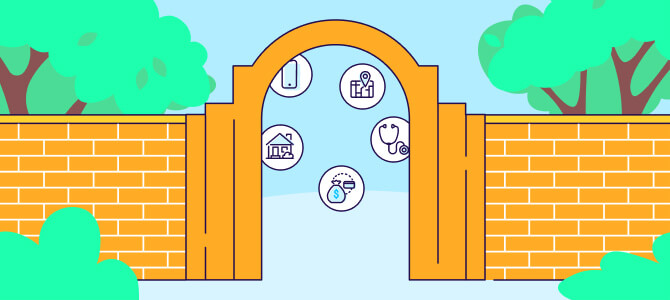
Walled Garden

In the world of AdTech, a walled garden is a closed platform or ecosystem where the technology provider controls the hardware, applications, or content being shared among the participating parties. In particular, it offers a way to share insights from aggregated data that can’t be tied to individual users.
What is a walled garden?
“Walled garden” has become quite the buzzword over the past few years, particularly in the context of digital advertising and privacy.
But what exactly is it?
Well, a walled garden is essentially a closed platform controlled by the technology provider (such as Google). In the world of AdTech, it offers a way for advertisers to gain valuable campaign insights that can’t be tied to a specific user or device. In return, advertisers and publishers are forced to use that platform, and all its inbuilt technology, to run their campaigns.
The biggest, and best known, walled gardens are Google’s Ads Data Hub (ADH), Meta’s Facebook Advanced Analytics (FAA), and Amazon Marketing Cloud (AMC).
These security-stringent environments are where the mega self-reporting networks (SRNs) make event-level data accessible for marketers so they can make informed campaign decisions, without jeopardizing consumer privacy or the ecosystems’ closely-guarded defense moats.
How walled gardens are being used?

Some say that the tech giants have created a monopoly with their walled gardens. And you can see why, when you consider that around 70% of all online ad spend goes to Google, Meta and Amazon.
Given the scale of these operators, and the complexity of setting up and running a walled garden (more on this to come), it’s hard for other publishers to compete.
What’s more, walled gardens force advertisers to use their proprietary AdTech software, such as demand-side platforms and data management platforms — putting the “gardeners” firmly in control and helping them capture ad spend from rivals.
But for many advertisers and publishers, running campaigns via the big walled gardens still makes sense. Firstly, it makes the whole process simpler, as it’s all in one place — and secondly, where else are you going to get access to such vast amounts of data?
The key point is that none of the parties involved can see personally identifying information (PII) or attribution-restricted data on individual users. This means they can’t single out users by their unique identifiers.
Instead, these environments typically provide aggregate-level insights — for example, users who have performed action X should be offered Y.
Now that we’ve figured out the what, let’s peek into a few walled garden examples:
With a 92% share of the world’s search engine market, and around 1.8 billion Gmail users, Google is by far the largest digital advertising company in the world.
By using its Ad Manager walled garden, advertisers can harness the power of all that data to inform their campaigns.
Meta
Meta boasts around 2.9 billion users on its Facebook platform, and 2 billion on Instagram. That adds up to immense amounts of user-level data, resulting in one of the most comprehensive ad targeting capabilities out there.
Meta requires advertisers to use its data management platform (DMP), demand-side platform (DSP), and dynamic creative optimization (DCO), while keeping much of its campaign performance data in-house.
Amazon
Hot on the heels of Google and Meta is Amazon, which has come a long way from its beginnings as a cheap online bookstore. It generated $38 billion dollars through its Amazon Ads service in 2022, while its Amazon Prime service has 200 million subscribers globally.
It offers similar walled garden capabilities to Google and Meta, coupled with unique purchase data from sales worth over $500 billion a year.
The pros and cons of a walled garden

So, is a walled garden a restful retreat, or a prison you can’t get out of? That depends on how you look at it. Let’s dig into how they both help and hinder advertisers and publishers.
The pros
Benefit #1 – Enriching first-party data with event-level data
In a privacy-centric world, walled gardens are popular because access, availability, and usage of data are agreed upon by all parties, while data governance is enforced by the trusted provider.
This framework ensures that one party can’t access the other’s data, which upholds the ground rule stating that individual or user-level data can’t be shared between different companies without consent.
Both advertisers and publishers get to study large data sets in a privacy-compliant way, gathering audience insights on factors like reach and frequency, audience overlap, cross platform planning and distribution, purchasing behavior, and demographics.
Advertisers can get an aggregated output without individual identifiers, including segmentation and look-alike audiences, which can then be shared with a publisher, a DSP, or an ad network to inform a campaign.

Benefit #2 – Accurate campaign measurement
The data available in a walled garden environment enables both advertisers and publishers to reach their audience effectively, through personalized, relevant, and well-targeted campaigns.
Benefit #3 – User privacy
Stringent privacy and security standards are the foundation of walled gardens: the whole environment is designed to keep data in, and intruders out.
The big players invest heavily in security, for example encoding user-level data so other parties can’t see it. This gives advertisers and publishers confidence that their users’ privacy won’t be compromised.
Benefit #4 – Cross-device user engagement
You know when you do a Google search on your laptop, and then see an ad for that same product on your phone? That’s because you’re signed in across different devices.
This gives these platforms invaluable cross-device data that can then be shared with advertisers and publishers (anonymously) for the purpose of campaign reach, targeting, and optimization.
The cons
Disadvantage #1 – Limited data outputs
Walled garden providers are, understandably, fiercely protective of the data they hold. And when it comes to sharing the spoils with advertisers and publishers, they can sometimes be less than helpful.
Making sense of the aggregated data walled gardens provide can be labor intensive, requiring support from data scientists, analysts, or engineers. So, while it’s undoubtedly useful to have, getting actionable insights can take time.
Add to this the rigid architecture that can result in data elements being filtered without warning, and you may find the data you’re given doesn’t tell the whole story.
Disadvantage #2 – No cross-platform activation of data
The insights you get as an advertiser or a publisher can only be leveraged across the same walled garden network. In other words, you can’t take an insight found in Meta and apply it to Google.
Disadvantage #3 – Lack of collaboration between parties
Whereas on the open market, advertisers and publishers can form fruitful collaborations based on a shared audience, that’s not possible in a walled garden environment. They’re designed purely to aggregate first-party data, rather than promote bespoke collaboration between parties.
Disadvantage #4 – Putting all of your eggs in one basket
As Google prepares to phase out third-party cookies, it looks like many brands will need to play more in Google’s Sandbox as their only option. But, an over-reliance on one walled garden, instead of a balanced and healthy mix, might leave businesses exposed to various issues should something go wrong.
In addition, advertisers and publishers have no control over the walled garden provider’s decisions or algorithms, creating something of a black box.

Should you build your own walled garden?
If you’re a publisher who doesn’t want to hand over control to the big players, you might be wondering about creating your own walled garden.
While you don’t need a green thumb to do this, you do have to put in significant time, budget, and expertise — which is why so few companies are able to do it.
Operating a walled garden isn’t just about safe-guarding data: you’ll need your own AdTech, like a DSP, DMP, and DCO, plus a full in-house squad of trackers, developers, designers, and a management team to piece all of these individual elements together. Scaling your garden, and maintaining it over time, is also costly and time-consuming.
If you do have the resources to make it work, though, your garden could bear fruit by enabling you to control revenue and advertiser relationships, protect your first-party data, customize ads, and bypass ad blockers.
The future of walled garden in AdTech
The walled garden platforms offered by the likes of Google, Amazon, and Meta have an important role in the lives of every single player throughout our ecosystem — including publishers, advertisers, and marketers.
But could the walls start to crumble?
Amazon and Meta have been talking about giving advertisers more insights into behavioral data. In a cookieless future where opt-ins are everything, that could well be a popular move.
Other platforms may be forced to make changes — think, for example, about the recent controversy over Apple and Google’s stronghold on the tap-to-pay ecosystem, which locks customers into one system or the other.
We can’t talk about the future without mentioning AI. And in the case of walled gardens, generative AI could be the key to quickly creating new features that keep users inside.
Basically, if advertisers and publishers stop seeing the value in walled gardens, they’ll look for other solutions — the rise of header bidding is an example, as publishers seek to bypass the gardens and get better deals on their inventory.
Key takeaways
- A walled garden is a closed platform controlled by the technology provider, which enables advertisers and publishers to access aggregated, non-identifiable data to inform digital campaigns.
- Within this environment, the walled garden provider has significant control over the hardware, applications, or content being shared among the participating parties. This means advertisers and publishers have to use the platform’s technology, while user data is encrypted and can’t be shared between parties.
- Google, Meta, and Amazon dominate the walled garden landscape, with little room for competitors. Many advertisers and publishers are willing to hand over control of their campaigns to these giants, in order to benefit from their vast reserves of first-party data.
- The main benefit of walled gardens is their ability to turn user-level data into aggregated insights, thereby protecting user privacy. They also enable accurate campaign measurement and cross-device engagement.
- On the flipside, the data they share with advertisers and publishers can be limited, rigid, and hard to interpret. Walled gardens don’t allow insights to be shared across platforms, or enable cross-company collaboration. And they encourage marketers to put all their eggs in one basket, which can be a risky strategy.
- Building your own walled garden gives you more control over your ads, relationships, and revenue. But the set-up and ongoing management is costly and labor-intensive.
- While walled gardens remain closely guarded, we could see them open up as advertisers demand better insights and markets become more competitive.



